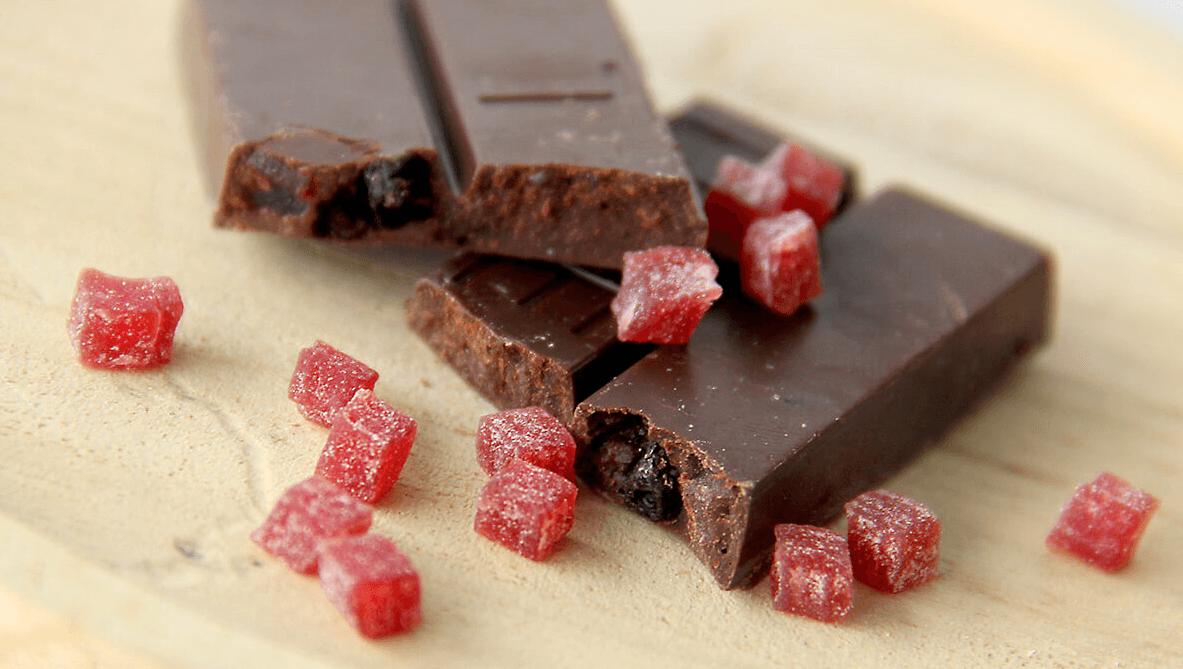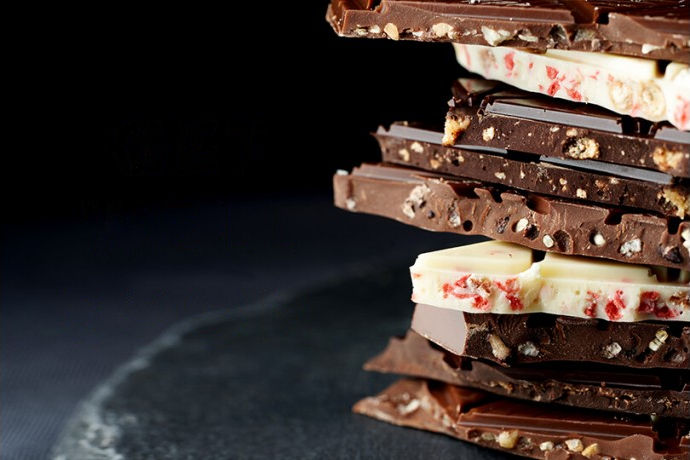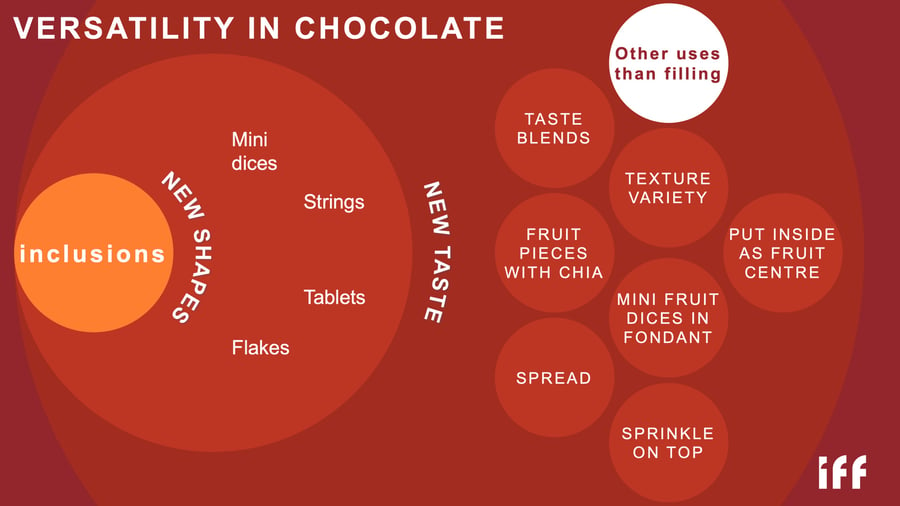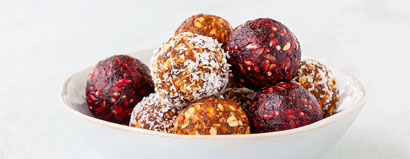Why Chocolate + Fruit Still Wins
Chocolate and fruit remain a powerhouse pairing - delivering indulgence, excitement, and a health halo in one bite. Here’s why it works:
Taste harmony: When balanced correctly, fruit adds a bright top note without overpowering chocolate. Orange, coconut, and strawberry remain global favorites, while tropical and citrus-forward flavors like mango, passion fruit, and yuzu are trending upward. Premium innovation is also embracing emerging fruits such as acai, dragon fruit, and guava, along with creative pairings like botanical blends (lavender + berry) and spiced fruit combinations (chili + mango) to deliver adventurous, multi-sensory experiences. (MINTEL)
Textural excitement. Consumers want layered experiences; texture (crunch, chew, aeration) enhances perceived indulgence and modernizes classic formats - an emphasis Mintel expects to accelerate in 2025 as “multi‑sensory” becomes a core differentiator.
Premium + better‑for‑you. 2025 chocolate innovation balances indulgence with health cues (lower sugar, added benefits) and values (plant‑based, ethical). Expect continued growth in portionable/bite formats and plant‑based lines as brands address “mindful” and “healthy indulgence." (INNOVA Global Chocolate Trends_2024)
What to build for in 2025 (manufacturer lens)
Multi‑sensory formats: “Chunky/loaded/duo” bars and textural mashups continue to win attention and trade‑up.
Exploratory flavors, familiar anchors: Pair an exotic top note with a classic base to de‑risk trial (e.g., milk chocolate + mango‑chili).
Plant‑based portfolios: Vegan/dairy‑free coverage is moving from optional to expected in many ranges. (INNOVA Chocolate Trends 2024)

Which fillings work with chocolate?
Chocolate products use creams, pralines, fondants, jellies, and inclusions (fruit, nuts, grains). For shelf-stable chocolate, engineered fruit inclusions are preferred - they control size, water activity (aw), and handling, avoiding leakage risks from high-moisture centers.
5 Key Challenges—and How to Solve Them
Size, processability, consistency, safety and moisture migration present critical challenges which compromise successful product development. Luckily, inclusions can offer solutions which clear those hurdles and deliver consumer-preferred experiences.
How fruit inclusions help to overcome the technical difficulties of chocolate with fruit
 Image credit: Awfully Chocolate
Image credit: Awfully Chocolate
Inclusions are creative specialty ingredients that can be ‘included’ in a finished food product. They can provide great taste, appealing texture and inspiring visual appearance.
1. Size
Common problems with traditional fruit ingredient size include:- Irregular size: ingredients like dried fruits or raisins are often irregular in size, which can be difficult to work with.
- Impact of ingredient size on dosage: fruit is difficult to get into easy sizes for even distribution in the production process. This can create risks of blocking machinery or uneven spreading in the application.
How inclusions can solve problems with fruit ingredient size:
- Even size for easy dosage
Fruit inclusions come in different formats and sizes starting from 3mm up to 30 mm. Whether you want a natural looking flake, a dice, rectangle, tablet or string: inclusions come in a consistent size, making it easy to control dosage and spreading in the production process.
2. Processability
Common problems with processability of fruit ingredients include:- Intense production process: fruits are delicate and not every fruit ingredient can withstand the steps in an intense production process, like mixing or baking.
- Stickiness: many fruit ingredients are sticky and require extra handling, which makes them difficult to work with in production at scale.
- Brittleness: some fruit ingredients may be free flowing but also brittle, resulting in an unpleasant texture in the application.
How inclusions can solve problems with processability of fruit ingredients:
- Easy processability
- Constant, even in intense production process: with formulas adapted to the desired end use, fruit inclusions can withstand an intense production process, like mixing or baking.
- Free flowing: a fine layer of dusting ensures that fruit inclusions stay free flowing, making large scale production easy to control, while keeping the chocolate at its best.
- Maintain texture: unlike some other fruit ingredients, fruit inclusions are designed to keep their pleasant chewy texture in the end application.
3. Consistency
Common problems with consistency of fruit ingredients include:- Taste balance: as taste is the major trigger for chocolate consumers, this is the most important parameter to control in production. When working with fruit ingredients, make sure the taste is not too intense or overwhelming.
- Color: make sure to check the color stability of fruit ingredients in the chocolate product.
- Line set-up for other flavor variants: be mindful that switching the production line from one fruit flavor variant to another can be time consuming and can involve several checks for parameters.
- Temperature: chocolate reacts to all changes in temperature. Therefore, the fewer temperature shocks brought into a chocolate factory, the better. Sometimes IQF (frozen) fruit is used, which can create a problem in a temperature sensitive environment like a chocolate factory.
How inclusions can solve problems with processability of fruit ingredients:
- The right taste balance: Whether you look for more intense, or more subtle taste, there is always a tailor-made inclusion available to match your signature chocolate.
- Consistent Color: fruit inclusions are cut out of a large fruit carpet, which has a natural looking and consistent color.
- Easy line extensions: a changeover from one fruit flavor to another is easy with fruit inclusions: an apple inclusion will perform in exactly the same way as an orange inclusion, which makes frequent changes for production of smaller batches (e.g., limited editions) much easier.
- Ambient temperature: ambient fruit inclusions are easy to store and avoid temperature shocks in the sensitive chocolate production environment.
4. Safety
Safety checkpoints for ingredients for chocolate manufacturers include:
- water activity (aW)
- shelf-life guarantee
- allergen-free
- contaminant-free
How inclusions can solve safety problems with fruit ingredients:
- very low water activity (aW 0.3 - 0.6)
- long shelf life (up to 18 months)
- allergen-free
- contaminant-free
5. Moisture migration
Why most fruit ingredients are difficult to work with in terms of moisture:
- Fruit is naturally rich in moisture/juice. For example, combining chocolate with fruit creates the risk of leakage: the fruit filling might leak through the chocolate, causing sticky packaging or smudged, non-attractive chocolate - not what a consumer wants.
How inclusions can solve moisture challenges with fruit ingredients:
- Moisture control. With a water activity between 0.3 and 0.6, fruit inclusions are a safe and controllable way to bring rich fruit flavors in a sensitive product like chocolate.

Looking for more inspiration for chocolate?
In a fast-changing market, we help you to find winning combinations for delightful on-trend chocolate products.




